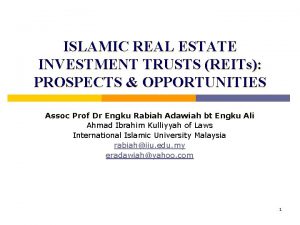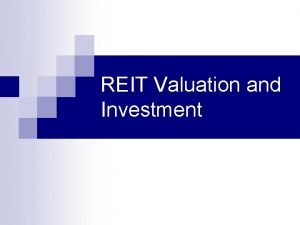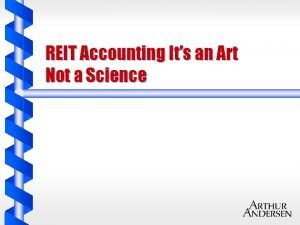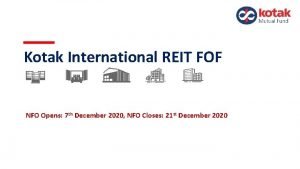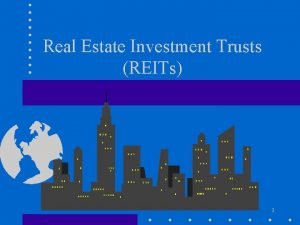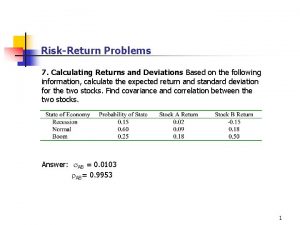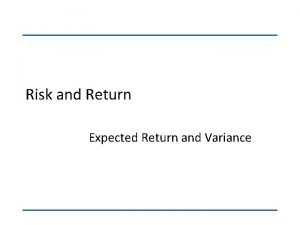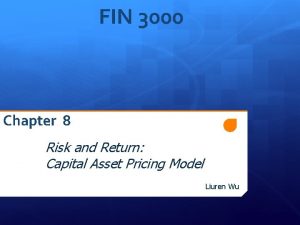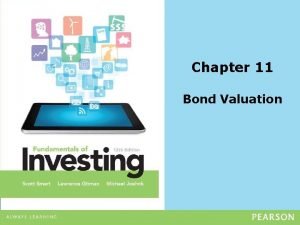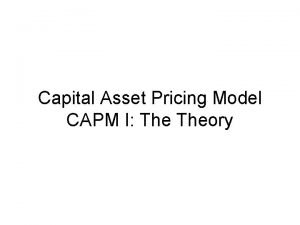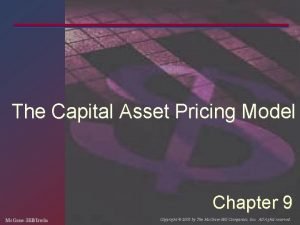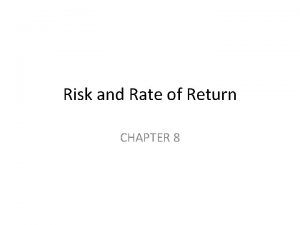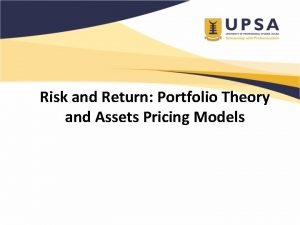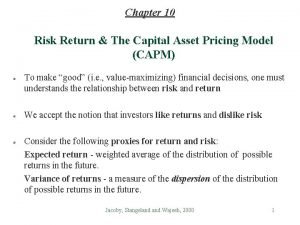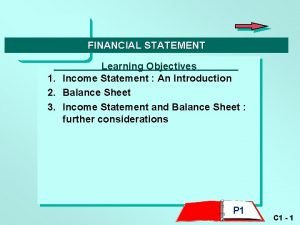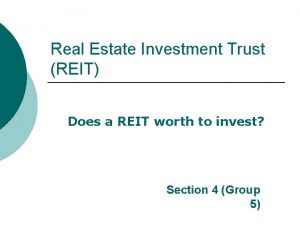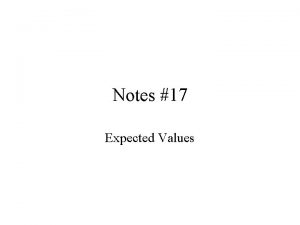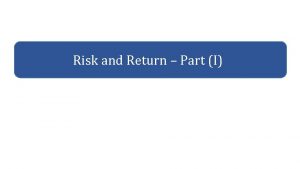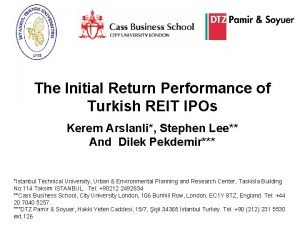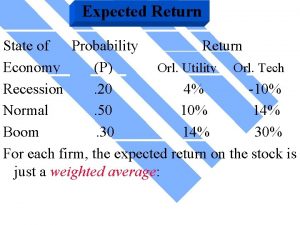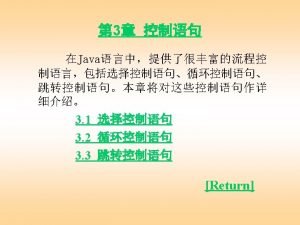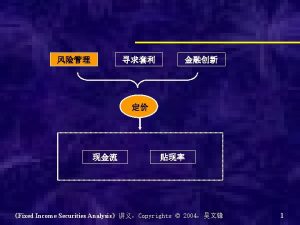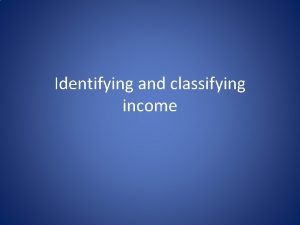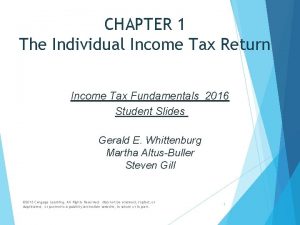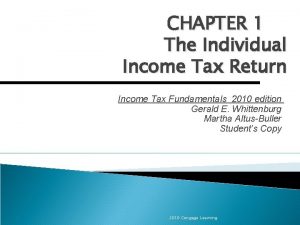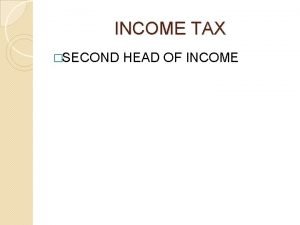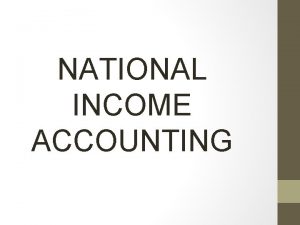RETURN OF REIT AND EXPECTED INCOME GROWTH OF




















- Slides: 20

RETURN OF REIT AND EXPECTED INCOME GROWTH OF REAL ESTATE ASSET Sherry Y. S. Xu Department of Real Estate and Construction Faculty of Architecture The University of Hong Kong

RESEARCH QUESTIONS Is there relationship between REITs and real estate market? Which elements of the two markets can be linked? How would these elements relate to each other?

PROPOSITIONS As the underlying portfolio of REIT, the real estate asset would has certain relations to its return. Though actual rent growth cannot reflect the return of REIT, it would have dependence on the expected rent growth of underlying real estate assets.

RESEARCH OBJECTIVES Dependent variable: total return of REITs Independent variables: 1) stock market factor ---- stock market price index 2) economic factor ---- real interest rate 3) real estate market factor ---- expected income (rent) growth of real estate asset

what is expected income growth? The expected income growth can be defined as the rate at which the cash-flow of certain asset will grow over a period of time For real estate asset, the expected income growth can be regarded as the rent growth of the property in the investors’ expectation.

where does expected income growth come from? DCF Model first formally expressed in Fisher (1930) and Williams (1938)’s work • Gordon Growth Model a variant of DCF model was derived by Gordon (1959) Here, P, D, g, k represent the asset’s value, income, expected income growth and required return rate respectively.

what is expected income growth usually used for? Evaluation of the asset’s price Prediction of the asset’s return *in most of the previous research, the assets are almost stocks, REITs and real estate assets. Several very important relationships: price expected income growth Income yield expected return

Previous literatures on the application of expected income growth Some of the recent research adopting expected income growth Article Assets examined Applications Chen et al. (2004) Real estate Hung and (2008) Glascock REITs Data Testing Methods Time period OLS Model 1982 – 2003 REITs’ returns from the VAR Model CRSP database 1997 – 2000 to evaluate the real estate NOI index by NCREIF asset as one of several factors in the model to find out the momentum return of REITs when dividend yield is shock to test the momentum effects in stock returns under condition that the expected dividend growth varying over time Johnson (2002) Equities Equity (especially real VAR Model estate stocks) returns from the CRSP database 1993 – 2000 Plazzi et al. (2008) Commercial real to measure the risk of Returns and growth in VAR Model estate commercial real estate rents of commercial real investment estate on metropolitan areas 1986 – 2002 Shilling and Sing (2007) Real estate Sing et al. (2007) to predict the return of Return from NEREIF data VAR Model real estate asset base and ex-ante return from Korparz Survey 1988 – 2006 Property and to predict the returns of Real estate return (URA of VAR Model property stock both property and Singapore) and property stock return (SGX-PTYS) 1988 – 2006

What are the common methods to get the expected income growth the conventional estimating method : VAR model (Vector Auto Regressive) (first applied in Campbell and Shiller (1988 a, b)’s research) based on different datasets 1) historical income growths 2) historical income yields

Previous literatures making estimation of expected income (dividend) growth Some of the recent research estimating expected income growth Article Ang and Bekaert (2007) Assets examined Equities Estimating method(s) Data Time period Ang and Liu (2007) Equities Bansal and Yaron (2004) Equities auto-regressive model Equity prices and realized 1929 – 1999 consumption growth data Chiang (2008) REITs Fama (1990) Equities Fama and French (2001) Equities auto-regressive model Center for Research in 1980 – 2006 Security Prices (CRSP) / Ziman Real Estate Database for REITs’ returns auto-regressive model Annual NYSE value- 1953 – 1987 weighted returns auto-regressive model CRSP and Compustat 1926 – 1999 Lettau and Ludvigson (2005) Equities auto-regressive model Stock dividend and return 1947 – 2001 from CRSP Menzly et al. (2004) Equities Schwert (1990) Equities auto-regressive model CRSP value-weighted 1948 – 2001 stock market index auto-regressive model NYSE value-weighted 1889 – 1988 returns auto-regressive model S&P 500 stock price 1935 – 2001 return and total return auto-regressive model S&P 500 return data 1935 – 2001

Why to construct a new model 1) VAR model can be a good forecasting model, but in a sense it is an atheoretical model. 2)The problem of the predictability of the expected income growth.

Deviation of the new model Based on Gordon Growth Model, we further assume that the required rate of return (i) would change with constant growth (G) as well, then we get the variant of GGM: (1) Here, P = price of asset, D = income of asset, g=expected income growth, i=required rate of return, G = the growth of required rate of return

How to find out growth of required rate of return Required rate of return (i) = cost of capital = risk-free return rate =yield of government bond is equal to growth of i growth of bond yield spread of bond yield (S) = longest-period bond yield (i. L) – shortest-period bond yield (i 0) (2)

the expected income growth model Combining equation (1) and (2), we can get the model for capturing the expected income growth of certain asset as followed: Solving the function above with Newton-Raphson Method, the expected income growth of asset (g) can be calculated

Study in Hong Kong market 0, 80% DERIVED EXPECTED RENT GROWTH (Jan 1999 to Mar 2009) 0, 60% 0, 40% 0, 20% 0, 00% янв-99 янв-00 янв-01 янв-02 янв-03 янв-04 янв-05 янв-06 янв-07 янв-08 янв-09 -0, 20% -0, 40% -0, 60% -0, 80% -1, 00% residential office (a) retail industrial Source: Rating and Valuation Department, Hong Kong SAR & Hong Kong Monetary Authority

Study in Hong Kong market (continued) ACTUAL RENT GROWTH 15, 00% (Jan 1999 to Mar 2009) 10, 00% 5, 00% 0, 00% янв-99 янв-00 янв-01 янв-02 янв-03 янв-04 янв-05 янв-06 янв-07 янв-08 -5, 00% -10, 00% residential office (a) retail industrial Source: Rating and Valuation Department, Hong Kong SAR & Hong Kong Monetary Authority янв-09

EMPIRICAL TEST Empirical model: Here, Rit and ERGit refer to the total return and weighted expected income growth of certain portfolio of the ith REIT at time t respectively; HSIt, INTt, INFt represent the Hang Seng Index, Interest rate and Inflation rate in Hong Kong at time t respectively.

EMPIRICAL TEST (continued) Empirical results: ① Return of all REITs in Hong Kong show strong positive dependence on the stock market factor; ② Three of them show significant negative relationship with real interest rate; ③ One of them shows significant positive dependence on the expected rent growth of its underlying real estate

Conclusions The contributions of this study: combining the government bond market with asset market to find out the change of time value of the money; l capturing the expected income growth based on a mathematical model other than forecasting investigation or econometrics model; l finding out the relationship between REITs market and direct real estate market. l

References ANG, A. & BEKAERT, G. (2007) Stock Return Predictability: Is it There? Review of Financial Studies, 20, 57. ANG, A. & LIU, J. (2007) Risk, return, and dividends. The Journal of Financial Economics, 85, 38. BANSAL, R. & YARON, A. (2004) Risks for the Long Run: A Potential Resolution of Asset Pricing Puzzles. Journal of Finance, 59, 29. CAMPBELL, J. Y. (1991) A Variance Decomposition for Stock Returns. The Economic Journal, 101, 23. CAMPBELL, J. Y. & SHILLER, R. J. (1988 a) The dividend-price ratio, and expectations of future dividends and discount factors. The Review of Financial Studies, 1, 34. CAMPBELL, J. Y. & SHILLER, R. J. (1988 b) Stock prices, earnings, and expected dividends. Journal of Finance, 43, 16. CAMPBELL, J. Y. & YOGO, M. (2006) Efficient tests of stock return predictability. Journal of Financial Economics, 81, 34. CHEN, J. , HUDSON-WILSON, S. & NORDBY, H. (2004) Real Estate Pricing: Spreads & Sensibilities: Why Real Estate Pricing Is Rational. Journal of Real Estate Portfolio Management, 10, 21. CHIANG, K. C. H. (2008) High dividend yield does predict lower dividend growth: a natural experiment. Burlington, University of Vermont. FAIR, R. C. & SHILLER, R. J. (1990) Comparing information in forecasts from econometrics models. The American Economic Review, 80, 15. FAMA, E. F. (1990) Stock Returns, Expected Returns, and Real Activity. The Journal of Finance, 45, 20. FAMA, E. F. & FRENCH, K. R. (1988) Dividend yields and expected stock returns. Journal of Financial Economics, 22, 19. FAMA, E. F. & FRENCH, K. R. (2001) Disappearing dividends: changing firm characteristics or lower propensity to pay? Journal of Financial Economics, 60, 41. FISHER, I. (1930) Theory of Interest as Determined by Impatience to Spend Income and Opportunity to Invest it, New York, The Macmillan Company. GORDON, M. J. (1959) Dividends, Earnings and Stock Prices. Review of Economics and Statistics 41, 99 --105. HODRICK, R. J. (1992) Dividend Yields and Expected Stock Returns: Alternative Procedures for Inference and Measurement. the Review of Financial Studies, 5, 30. HUNG, S. -Y. K. & GLASCOCK, J. L. (2008) Momentum Profitability and Market Trend: Evidence from REITs Journal of Real Estate Finance and Economics, 37, 19. JOHNSON, T. C. (2002) Rational momentum effects. Journal of Finance, 57, 24. KEIM, D. B. & STAMBAUGH, R. F. (1986) Predicting returns in the stock and bond markets. The Journal of Financial Economics, 17, 34. KOTHARI, S. P. & SHANKEN, J. (1992) Stock return variation and expected dividends : A time-series and cross-sectional analysis. Journal of Financial Economics, 31, 34. KOTHARI, S. P. & SHANKEN, J. (1997) Book-to-market, dividend yield, and expected market returns: a time-series analysis. Journal of Financial Economics, 44, 35. LETTAU, M. & LUDVIGSON, S. C. (2005) Expected returns and expected dividend growth. Journal of Financial Economics, 76, 44. MENZLY, L. , SANTOS, T. & VERONESI, P. (2004) Understanding Predictability The Journal of Political Economy, 112, 47. PLAZZI, A. , TOROUS, W. & VALKANOV, R. (2004) Expected Return and the Expected Growth in Rents of Commercial Real Estate. Los Angeles, UCLA. PLAZZI, A. , TOROUS, W. & VALKANOV, R. (2008) The cross-sectional dispersion of commercial real estate returns and rent growth: time variation and
 Reit definition
Reit definition Funds from operations formula
Funds from operations formula Vertical scope stock
Vertical scope stock Reit art
Reit art Reit
Reit Doc reit
Doc reit How to calculate expected return
How to calculate expected return Expected return
Expected return Expected rate of return
Expected rate of return Expected return beta relationship
Expected return beta relationship Required rate of return formula
Required rate of return formula Calculate duration of bond
Calculate duration of bond Capm derivation
Capm derivation Slope of sml
Slope of sml Return
Return Calculate expected portfolio return
Calculate expected portfolio return Capital market line
Capital market line Jensen alpha ratio
Jensen alpha ratio Winman software download
Winman software download Carriage inwards income statement
Carriage inwards income statement How to calculate real gdp per capita
How to calculate real gdp per capita
